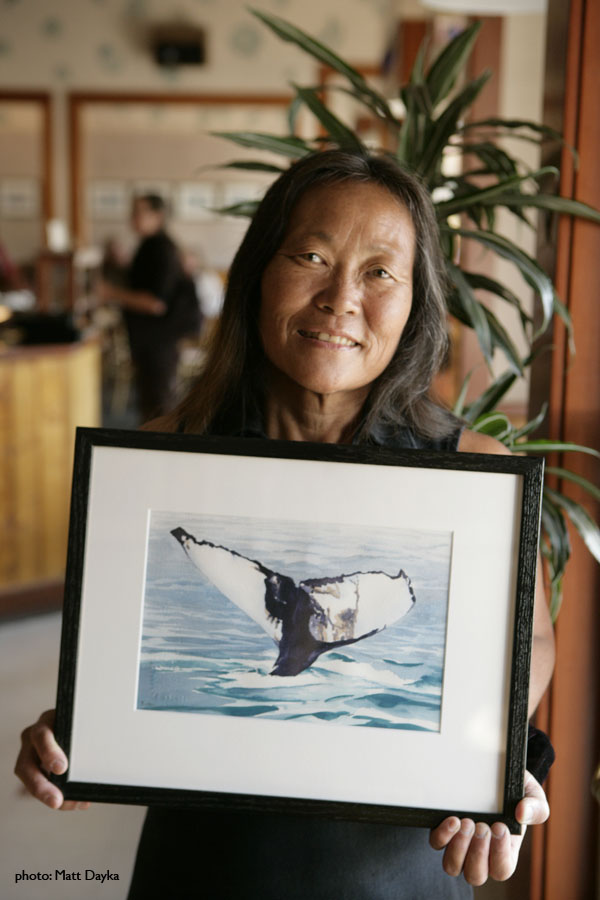
Through “Homage to Megaptera” I present 50 flukes as portraits from actual photo identification records of individual Humpback Whales, sited off Antarctica. These Humpback Whales migrate annually from their calving and mating grounds in subtropical and tropical zones to the Antarctic waters to feed. Fifty “portraits” are presented in this exhibit in response to an announcement in 2007 from the Japanese Fisheries Agency of a quota of 50 Humpbacks, along with 50 Fin whales (also an Endangered Species), and 850 Minke whales during their next Antarctic hunt. In late December 2007, the Japanese government announced "Suspension for a year or two, but no change in stance on 'research whaling'...Despite the suspension of the humpback hunt, Japan still planned to take as many as 935 minke whales and up to 50 (endangered) fin whales in the Antarctic in what the Fisheries Agency says is its largest-ever scientific whale hunt. Again, in late 2009 "Japan uses (50) humpback permit in talks". Japan also takes more minkes in the northern Pacific later in the year.
It is my hope that viewers will recognize all whales as individual sentient beings. What do whales think and feel? Considering their level of intelligence, I wonder what the lives of whales are like, what their interactions with each other and other species are like, and how they perceive the environments that they encounter as they roam the vast and deep oceans of the world. How, if they so chose, would they express their perceptions and knowledge of a world that we humans know so little of?
Likened to fingerprints in human identification, the shape, color patterns, marks and scars on whale flukes and fins used to identify each individual “are probably incurred during interactions between the whale and its environment, including, in the case of toothmarks, potential predators and animals like pilot whales ‘playing with’..., parasites, collision with different things, and maybe each other.”. “Thus the distribution of marks on an individual’s flukes says something about its experiences.”*
A few centuries marked the relatively short time that whalers drove the great whales to Endangered Species status. Humpback Whales; highly intelligent mammals that have inhabited the oceans for millions of years, currently are at about 30-35% of the estimated pre-whaling population.
Fifty may not seem like such a large number. However in relative terms, out of 35,000 (the current estimated world population of Humpbacks) 50 Humpbacks equals about .00143% killed in one season. This percentage translated to the current estimated world human population (6.6 billion), equals 9,438,000 humans. For another perspective, the relatively small number of Humpback Whales living in the world’s oceans today is approximately one-third of the current population of the city of Santa Barbara (not inclusive of the cities of Carpinteria, Summerland, Montecito, and Goleta).
The total for this year between Japan, Norway, and Iceland whaling quotas of six different species comes to 2,461 whales (MInke, Brydes, Humpbacks, Fin, Sei, and Sperm whales; the latter four Endangered Species). When considering the number of whales that die annually as a result of whaling, it is important to point out that there are numbers of whales that are “struck and lost”, not “landed” or counted as “takes”, which suffer and die later. Whales that are “struck and lost”, may live on after their injuries. But, as a result of infection, restricted mobility, shattered joints or damaged central nervous system, they may suffer an inability to feed, socialize or reproduce. The high proportion of struck, but lost, animals in some hunts is a serious welfare as well as conservation issue.
Because of the large size and their remarkable physiological adaptations for diving, whales may in fact still be alive long after having been judged as dead. According to the Humane Society of the United States, “...death is almost never instantaneous. Instead, the whale may suffer anywhere from a few minutes to several hours.” The Whale and Dolphin Conservation Society “is very concerned that the weapons which produce a poor instantaneous death rate in Japan’s Minke whale hunt, will be used to kill the much larger Fin whales, without adequate adaption to account for different size and physiology. The results could be horrific”. Humpback whales are 2.5 - 4 times larger, and Fin whales are up to 12 times heavier than Minkes.
Respect for Life, concern for animal welfare, and the possibility of species extinction are valid reasons to bring a complete halt to the disgrace of killing whales. It is time to make a strong appeal to the governing bodies of the world and the International Whaling Commission (IWC) to halt this cruel and unnecessary slaughter.
* Quotes are from Dr. Hal Whitehead, a world-reknowned researcher of whales.